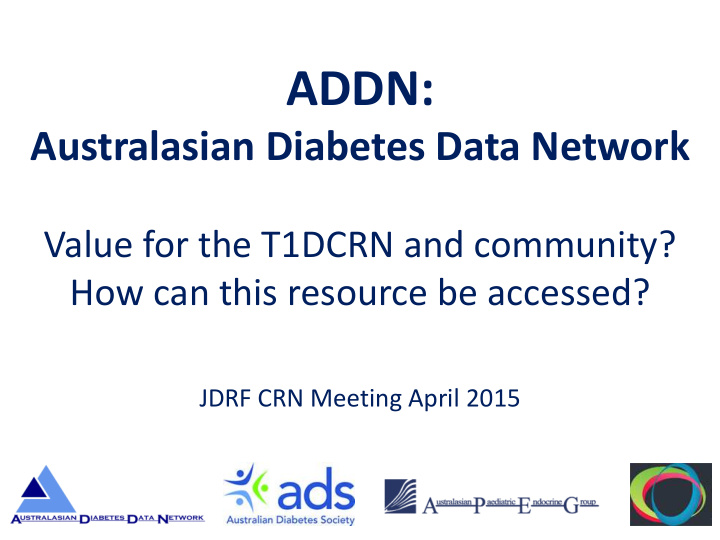



ADDN: Australasian Diabetes Data Network Value for the T1DCRN and community? How can this resource be accessed? JDRF CRN Meeting April 2015
Study sites and investigators Phase 1: Major sites in Australia NSW Maria Craig (PI), Kim Donaghue WA Tim Jones (PI), Liz Davis QLD Andrew Cotterill, Jerry Wales VIC Fergus Cameron SA Jenny Couper, Elaine Tham NZ Craig Jefferies
ADDN Key Personnel • Project officers: – Helen Clapin and Helen Phelan • Data base developers: – Richard Sinnott and Loren Burns • ADDN management committee – Includes JDRF • APEG secretariat
ADDN • ADDN is a population based longitudinal register of young people with diabetes, from Australia and New Zealand • Links clinical databases in diabetes centres to a central web-based database, containing de- identified data • Database contains demographic information, clinical characteristics, management and complications/comorbidities
ADDN Objectives: Overall aim is to establish a secure, centralised data repository containing de-identified longitudinal data, which facilitates research and improves the health of people with type 1 diabetes by enabling: 1. Population based recruitment of patients with specific characteristics for trials in new onset and established type 1 diabetes
ADDN Objectives 2: 2. Act as a database of interventions and outcomes over time, allowing researchers to conduct prospective and retrospective analyses and hypothesis generating research 3. Hold clinically relevant data, enabling participating hospitals to audit, benchmark and review clinical practice and patient outcomes 4. Support advocacy on behalf of individuals and groups of people with diabetes by providing epidemiological data and clinical evidence.
Progress – April 2015 • Phase 1 nearing completion • Consent obtained on > 6000 people with T1D • Five major sites contributing data to ADDN Centre State Patients Princess Margaret Hospital for Children WA 952 Children’s Hospital at Westmead NSW 1204 Women’s and Children’s Hospital, Adelaide SA 419 Royal Children’s Hospital, Melbourne Vic 1330 Lady Cilento Children’s Hospital, Brisbane Qld 507
ADDN interface: • Contains a dashboard that gives an overview of the project status • A registry query tool that can be used to establish the number of patients meeting a broad range of selection criteria (to assist with study planning) • Users can request a range of reports with fully configurable parameters
ADDN Phase 2 • PIs appointed by APEG and ADS – Maria Craig, Tim Jones, Peter Colman • Request for funding submitted March 2015 • EOI sought for participation by paediatric and adult centres – aim to include 16 additional sites by end of Phase 2 • Discussions underway to establish international collaborations
ADDN potential research questions • Prediction of clinical outcomes based on patient characteristics, immunological signatures, biomarkers at diagnosis/beyond • Effects of technological interventions • Risk factors predicting outcomes including complications and hypoglycaemia • Correlates of psychosocial morbidity • Benchmarking and comparison with international centres
How can ADDN data be accessed? • Governance framework established • Data access and publication policy developed – Currently awaiting sign off • General principles: – Discuss concept with ADDN co-ordinator or ADDN investigator(s); submit request for data; application assessed by ADDN committee • Will require revision in Phase 2 and beyond
Timeline
Conclusions • ADDN now established with five major centres contributing data on > 4000 patients across Australia • Phase 2 planning underway – aim to include wider spectrum of paediatric & adult centres • Key components of next phase include access to data and research output
Recommend
More recommend